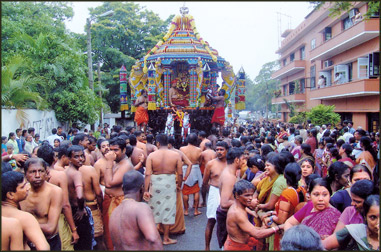Aadippoora Mahotsavam festival
by Chelvatamby MANICCAVASAGAR.
The 22nd year Aadippoora Mahotsavam of Mayurapathy Bhatharakali Amman
Devasthanam, Wellawatte, Colombo which commenced last week, will
conclude with water cutting ceremony on July 27 at the sea (Charlemont
Road Beach), Wellawatte.
 Further, the Aadippoora Paal Kudam (Milk Pot) festival will take
place on Saturday 25 starting from Bambalapitiya Samman Koddar Sri
Manicca Pillaiyar Temple at 7.30 a.m. Further, the Aadippoora Paal Kudam (Milk Pot) festival will take
place on Saturday 25 starting from Bambalapitiya Samman Koddar Sri
Manicca Pillaiyar Temple at 7.30 a.m.
In this colourful "Paal Kudam" festival more than 3,000 women both
young and old will go in procession to the accompaniment of Nathaswara
Music and devotional songs through Lorenz Road, Amerasekera Mawatha,
Havelock Road and finally will reach the temple at Mayura Place.
T. S. Eliot in describing the predicament of man states that the
progress in science and technology brings us knowledge of words, but not
of stillness!
Lord Shiva without Sakthi is all stillness since it is Sakthi which
stirs Him to motions and speech.
Shiva is the word, it is Sakthi which moves Him to words. The union
between them is represented by the image of Shiva as Artha Nariswara,
the half man and half woman. Further, Sakthi herself takes different
forms. Sometimes, she is stern and formidable. Furthermore, of the many
Gods in the Hindu Pantheon, none is revered more than Mother Goddess.
She is Parvathy, Durgai and Kali. Indeed, the compassion a mother shows
not only to her children, but also to the community, has no parallel.
In the religious parlance the "Divine Mother" is termed as the
extra-ordinary intermediary who pleads with God to show mercy to a real
penitent
when he may not be inclined to do so in view of the enormity of sins.
In fact, the Hindu temples are intended to educate men in the art of
removing the veil of attachment that covers their hearts. Thus, the
renowned poet "Thiyagarajah" cried in the temple at Thirupathi "Remove
the veil, O! remove the veil of attachment, the veil of pride and
hatred!
Further, in Hinduism, the supreme Lord is represented by Maheswara
and His power in turn is represented by His consort Sakthi, Devi, Durgai
and Kali.
Just as the husband and wife take care of their family so does Shiva
and Shakthi in looking after the affairs of the universe. Sakthi is the
embordiment of power. She is the supreme power with which the world is
made to function!
In fact, Colombo Mayurapathy Bathrakali Amman temple is a miraculous
one where several devotees have been cured of their sicknesses. Further,
Pon Vallipuram, a former collector of customs and a philanthropist is
rendering yeoman service as Trustee of this temple for more than two
decades. His services are immensely recognised by the devotees belonging
to all the communities.
He has also organised several cultural programmes in which Colombo
schools participate.
Srimathy Mangaiyarkarasi Sakthi Subramaniam from Tamil Nadu has been
specially invited to deliver religious discourses pertaining to "Rama
Avatharam", "Appar Peruman", "Arul Petra Arunakirinathar", "Mutpiravi',
"Kantha Puranathin Saram", "Vali Motsam", "Saint Manikkavasagar", "Muththaitharu
Vilakkam", "Karaikal Ammaiyar" and "Rama Pattabhesekam" commencing from
July 15 to July 24.
Srimathy Mangayarkarasi is a religious and Tamil scholar of
exceptional ability. While she was at Madursai R.C. secondary school she
was able to recite all the 1330 Thirukural and was highly commended by
teachers for her marvellous memory power. She was conferred with the
title "Thirukural Selvi."
In fact, the chariot symbolises human body and the statue of Sri
Bathrakali Amman is the soul. In front of the Chariot are the wooden
horses depicted as Galloping and the reins attached to their mouths are
held in the hands of the image of Sri Bathrakali Amman.
These horses represent human passion and the reins symbolise the
necessity of restraining and guiding these passions. The journey of the
chariot through the streets symbolises the progress of life. This shows
that throughout his life a man must control and guide his passions.
These passions are the motive powers, the driving force of life, but
unstrained and unguided they will wreck a man's life. This is the
symbolic meaning of the chariot festival. |

